Asia Investment Grade Bonds: Counting on Quality to Ride Regional Tailwinds

Omar Slim, CFA
Co-Head of Asia Fixed Income

Andy Suen, CFA, FRM
Co-Head of Asia Fixed Income

Emily Lam
Client Portfolio Manager, Fixed Income

Kelvin Heng
Portfolio Manager and Credit Analyst, Fixed Income

Jeremy Huang
Portfolio Manager and Credit Analyst, Fixed Income

US dollar-denominated Asia investment grade (IG) bonds are an appealing diversifier. Tested by a number of shocks over the past few years, Asia IG bonds have consistently offered compelling relative returns, especially when adjusted for risk.
Driven by steady credit metrics, a shorter duration profile, and attractive yields, Asia IG bonds continue to attract attention from both regional and global investors.
We expect Asia to drive global economic growth once again in 2023, with some of the few major economies likely to see accelerating growth when much of the world is slowing. Recent supportive economic policy announcements from China will add further market support. As such, we expect the Asia IG asset class to benefit from a number of supportive tailwinds.
Appetite for bonds is increasing as fixed income investors eye the benefits of generating income following the surge in yields. Yet continued headwinds, including a potential global recession, require a focused rather than broad-brush approach to benefit from exposure to higher-quality companies with the financial metrics to withstand an economic downturn.
This bodes well for US dollar-denominated Asia investment grade (IG) bonds. Key features of the asset class include compelling risk-adjusted returns, broadly steady credit metrics, a shorter duration profile, and a relatively higher yield, with the carry helping buffer against volatility.
These factors offer a compelling case for a selective focus on Asia IG bonds amid a global economic slowdown with recurring bouts of volatility.
Tilting toward tailwinds
While the world’s investors remain cautious about taking on much risk, Asia IG bonds broadly stand out for their track record of lower volatility and higher returns compared with counterparts such as US IG credit and emerging market (EM) bonds. Against the backdrop of a sharp selloff in the US dollar rates market in 2022, the Asia IG asset class was less impacted than similar markets, with a maximum drawdown of 14.77% (between August 2021 and October 2022), versus 19.80% for US IG (between July 2021 and Oct 2022) and 23.88% for global bonds (between December 2020 and October 2022).i Asia IG bonds also staged a recovery in the fourth quarter of 2022, ending the year with relatively better performance than other similar markets.
With such risk-adjusted returns, high-quality Asia credits can be an attractive diversifier in volatile markets, especially given that we expect this dynamic to persist for the foreseeable future.
Chart: Asia US Dollar Bonds Can Provide Diversification
Five-year total return history
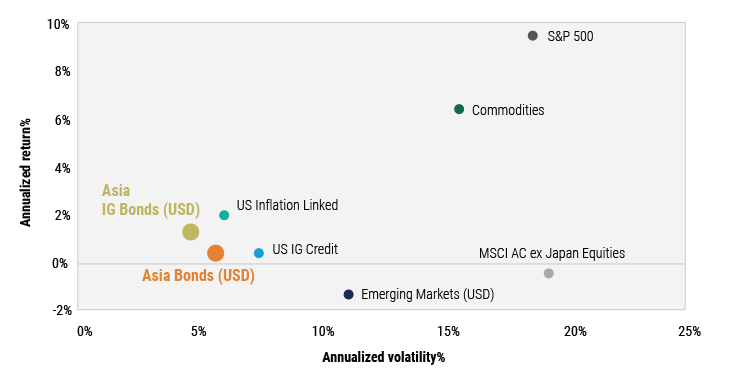
Sources: Bloomberg. Rolling five-year data as of 31 December 2022. Commodities represented by the Bloomberg Commodity Index, Asia USD Bonds by the JPM JACI index, Asia IG USD Bonds by JPM JACI Investment Grade, Emerging Markets (USD) by the JPM EMBI Global Diversified index, US Inflation Linked by Bloomberg US Inflation Linked index, US IG by BofA ICE index, US Equities by the S&P 500 index, and Asia ex Japan Equities by the MSCI MXASJ index. Diversification does not insure against market loss. For illustration only. There is no assurance that the investment strategies and processes mentioned herein will be effective under all market conditions. Investors should evaluate their ability to invest for a long term based on their individual risk profile, especially during periods of downturn in the market. Past performance, or any prediction, projection, or forecast, is not indicative of future performance.
The Asia IG market is anchored by solid fundamental, valuation, and technical factors.
Fundamentally, the steady nature of Asia IG credit metrics is reflected in the net leverage of high-quality corporate names, which has remained largely intact over recent years, and now sits comfortably within pre-Covid ranges. At 1.4x, it is about half of the 2.6x level in the US. This resiliency is also reflected in rating trends, where upgrades have outpaced downgrades since the start of 2021, and the total magnitude of fallen angels is expected to be muted over the course of 2023. It is worth noting that two-thirds of Asian IG issuers are government-related or quasi-sovereign entities whose final ratings are anchored by sovereign ratings, which provide an additional buffer over their standalone financial profiles. At the same time, the spreads and carry associated with Asia IG give these credits an important buffer against volatility.
Chart: Comparison of Corporate Net Leverage (IG)
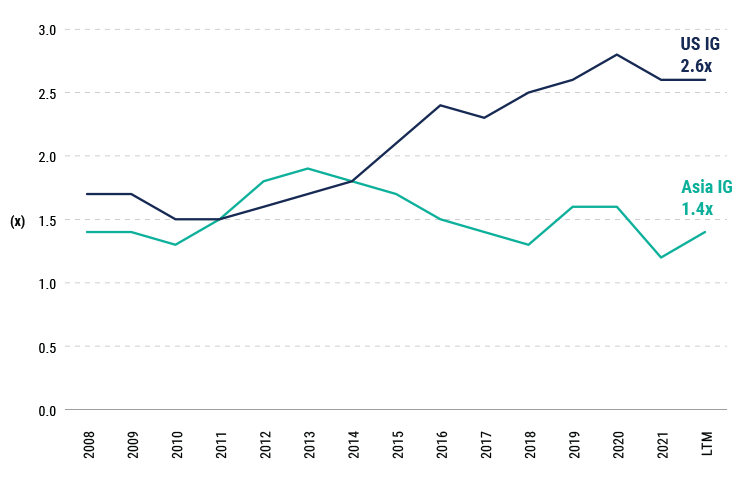
Source: J.P. Morgan, Bloomberg Finance L.P., CapitalIQ, PineBridge Investments, as of 30 September 2022. Any opinions are valid only as of the date indicated and are subject to change. For illustrative purposes only. We are not soliciting or recommending any action based on this material. Past performance, or any prediction, projection or forecast, is not indicative of future performance.
From a valuation perspective, Asia IG bonds also benefit from a shorter duration than peers, which provides support in an era of rising rates, as well as higher yields. Additionally, Asia IG bonds continue to have strong technical support given a growing money pool with a definite home bias that continuously invests in this asset class.
Chart: Asia IG Duration Is Shorter Than Peers’, Providing Support in a Rising-Rate Environment
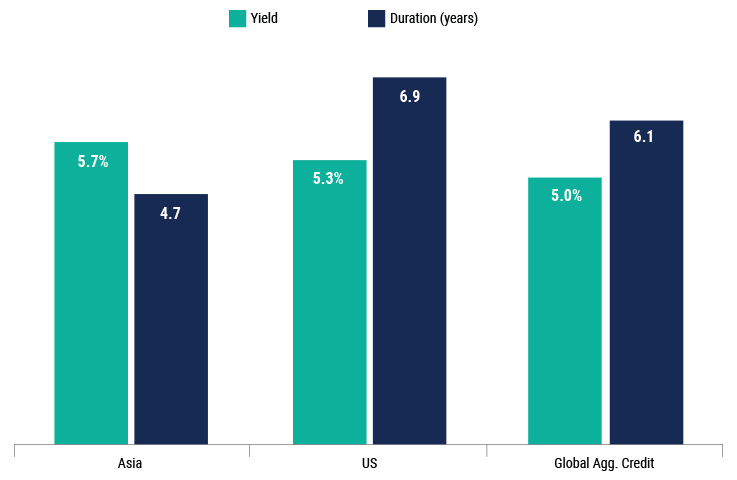
Sources: Data as of 31 December 2022. Asia represented by JPM JACI Investment Grade, US represented by Bloomberg US Credit Index, and Global by Bloomberg Global Aggregate Credit TR Index. Diversification does not insure against market loss. For illustrative purposes only. We are not soliciting or recommending any action based on this material
Chart: Asia Credit Issuance Draws a Diversified Real Money Investor Base That Skews Heavily Local
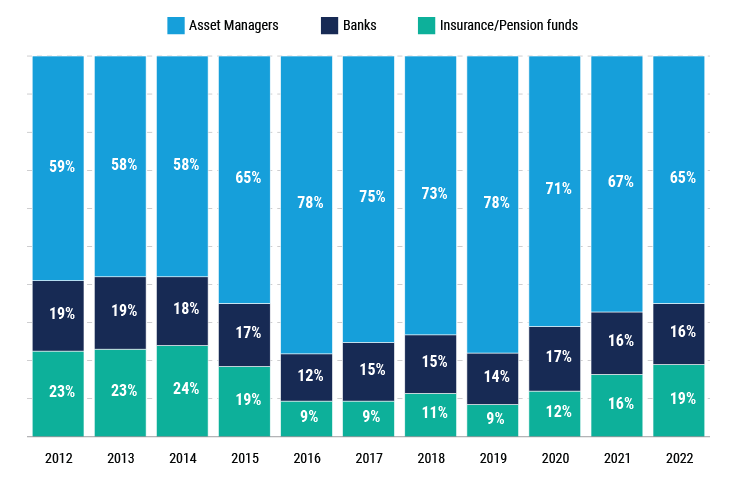
Sources: JP Morgan, PineBridge Investments. As of 30 September 2022. Any opinions, projections, forecasts, or forward-looking statements presented are valid only as of the date indicated and are subject to change. We are not soliciting or recommending any action based on this material.
China’s supportive economic policy turn
China will likely play a leading role in the robust story of Asia IG this year. Coupled with supportive monetary and fiscal measures, China’s recent swift and significant policy shifts to end most Covid controls and prop up the property sector offer scope for exposure to high-quality China credits – assuming the reopening of the economy remains on track.
We are optimistic about a reopening-driven growth rebound in China from the second half of 2023 and into 2024. However, we acknowledge uncertainties associated with the country’s long-term growth trajectory amid unfavorable demographic trends, potential increases in state control, and ongoing US-China tensions.
That said, we view policymakers’ major long-term objectives – of reducing systemic risk, enhancing the quality of economic growth, and maintaining social stability – as credit positive.
These shifts are already reflected in several key policy campaigns in recent years, including a campaign to deleverage the balance sheets of major state-owned enterprises (SOEs), regulatory tightening to reduce the size of the shadow banking sector (and hence systemic risk), and supply-side reforms to enhance capacity utilization and profitability in key industrial sectors. After short-term drags on growth when these initiatives were first introduced, the upshot from a credit perspective is that China is now generally better positioned than it was a few years ago, especially among the higher-quality credits.
Assessing where to invest requires careful credit selection, tilting toward those companies with the financial resources necessary to ride out a bumpy economic recovery. Domestically, this creates opportunities in the consumer and retail sectors, along with local property developers that have adequate liquidity. Meanwhile, in Greater China, select issuers in Hong Kong and Macau will likely benefit from a reopening to mainland China and beyond.
Diverse ESG profiles offer opportunities to be selective
The growing importance of environmental, social, and governance (ESG) factors has made us even more careful in our bond-selection process, and we see bright spots in the Asian credit universe. Based on our internal ESG methodology, technology, media, and telecom (TMT), real estate, and financial issuers have the best ESG metrics within Asia IG, with the best-rated ESG issuers coming from Singapore, Hong Kong, and South Korea. Issuers in Australia and Japan tend to be highly rated as well, and we see good investment opportunities there.
Furthermore, through our engagement and monitoring efforts across 180 companies (approximately 45% of the Asia IG universe) and 11 sectors, we’ve observed improvements in ESG practices in a quarter of the issuers we cover. Among those with improving ESG profiles, one-third come from mainland China, the country with the biggest market weight in the index.ii Our analysis show that the market is diverse and wide enough to allow us to be selective from an ESG perspective.
Chart: Several Sectors and Regions Show Improving ESG Practices
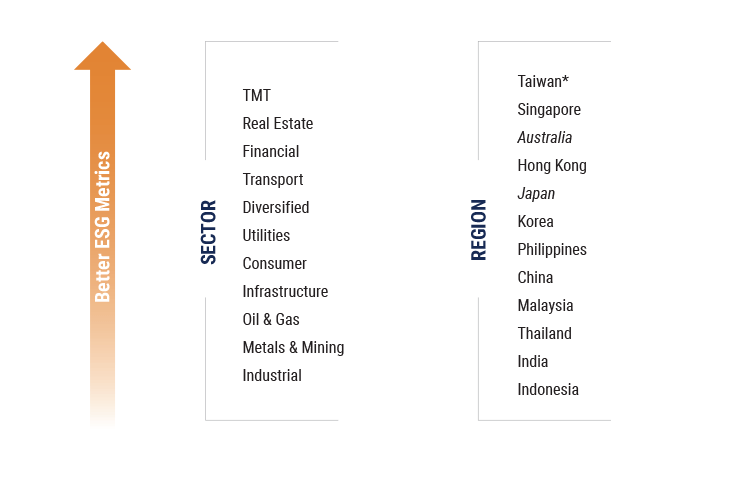
* PineBridge only covers one issuer in Taiwan. Source: PineBridge Investments as of 31 December 2022. For illustrative purposes only. Any views represent the opinion of the Investment Manager, are valid as of the date indicated, and are subject to change.
Adding to Asia allocations
The competitive profile of Asia IG bonds should help the asset class become better represented in global portfolios.
Despite the region’s being a key part of EM indices – across local currency, US dollar-denominated sovereign and quasi-sovereign, and US dollar-denominated corporates – Asia makes up a relatively small portion of global indices: somewhere between 3% and 6% (see charts below).
Chart: Asia Has a Substantial Presence in EM Indices
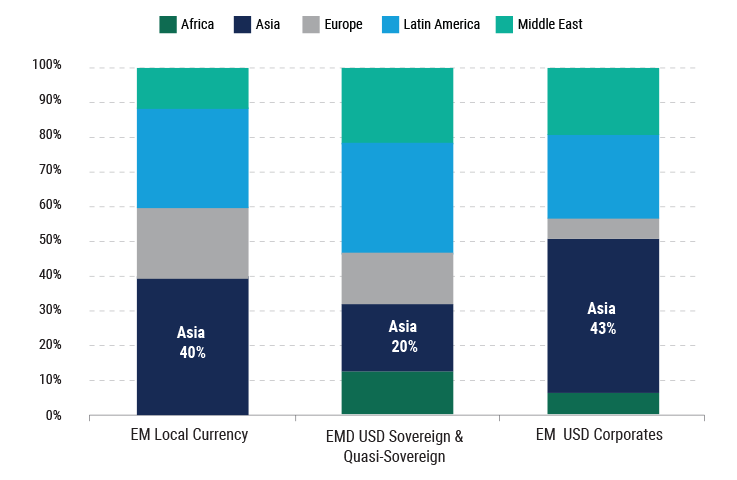
Chart: The Region Plays a Much Smaller Role in Global Indices
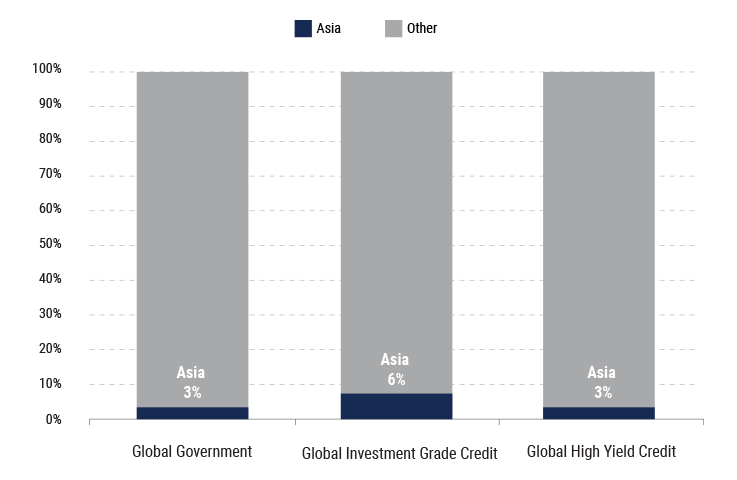
Sources: Top: JP Morgan, Bloomberg, PineBridge, as of 31 December 2022. Asia excludes Japan. EM Local Currency – Represented by the JP Morgan GBI-EM Global Diversified Index; EM USD Sovereign & Quasi-Sovereign – Represented by the Bloomberg JP Morgan EMBI Global Diversified Index; EM USD Corporates – Represented by the JP Morgan CEMBI Broad Diversified Index. Bottom: Global Government – Represented by Global Agg Treasuries Index; Global Investment Grade Credit - represented by Bloomberg Global Credit Index; Global High Yield Credit – Represented by Bloomberg Global High Yield Index. Any opinions, projections, forecasts, or forward-looking statements presented are valid only as of the date indicated and are subject to change. For illustrative purposes only. We are not soliciting or recommending any action based on this material. Past performance, or any prediction, projection or forecast, is not indicative of future performance.
Now seems a good time for a change in this mix. With market uncertainty expected to persist for some time, Asia IG’s strong fundamentals and demonstrated risk-adjusted returns, as well as its stable investor base, may be hard to find elsewhere in the global bond markets. Supported by strong and persistent technical factors – for instance, with the size of this market likely to decrease as maturities exceed new issuance in the coming year – as well as resilient fundamentals, Asian IG remains a compelling investment, and we expect it will retain its status as a core fixed income holding.
We believe a highly nuanced approach to credit selection can harness the advantages of this asset class more effectively, starting with a robust credit research process that analyzes bonds from both the bottom up and top down to build a portfolio likely to meet the volatility and return challenges of shifting markets.
Moreover, our investment thesis favors greater issuer differentiation to find value opportunities. For instance, among sovereign-linked issuers, understanding the differences and extent of sovereign support for various entities is key. And in some markets, despite sovereign credit rating downgrades, opportunities persist in specific issuers in more resilient sectors. Over the long run, multiyear credit trends such as China’s economic transformation and Asia’s continued economic rise should continue to drive performance in this asset class.
At the core of PineBridge’s global fixed income organization is a team of credit analysts who are highly experienced in different sectors and markets. This deep sector knowledge is combined with on-the-ground insights to help us create a complete credit picture of both the potential returns as well as the risks. We believe having the agility to reposition our portfolio according to market conditions is also important and may be harder to achieve through index tracking strategies.
Over the long run, the ability to navigate Asia’s changing economic, regulatory, and geopolitical landscape will likely play a key role in investing successfully in this asset class.
Disclosure
Investing involves risk, including possible loss of principal. The information presented herein is for illustrative purposes only and should not be considered reflective of any particular security, strategy, or investment product. It represents a general assessment of the markets at a specific time and is not a guarantee of future performance results or market movement. This material does not constitute investment, financial, legal, tax, or other advice; investment research or a product of any research department; an offer to sell, or the solicitation of an offer to purchase any security or interest in a fund; or a recommendation for any investment product or strategy. PineBridge Investments is not soliciting or recommending any action based on information in this document. Any opinions, projections, or forward-looking statements expressed herein are solely those of the author, may differ from the views or opinions expressed by other areas of PineBridge Investments, and are only for general informational purposes as of the date indicated. Views may be based on third-party data that has not been independently verified. PineBridge Investments does not approve of or endorse any republication of this material. You are solely responsible for deciding whether any investment product or strategy is appropriate for you based upon your investment goals, financial situation and tolerance for risk.
